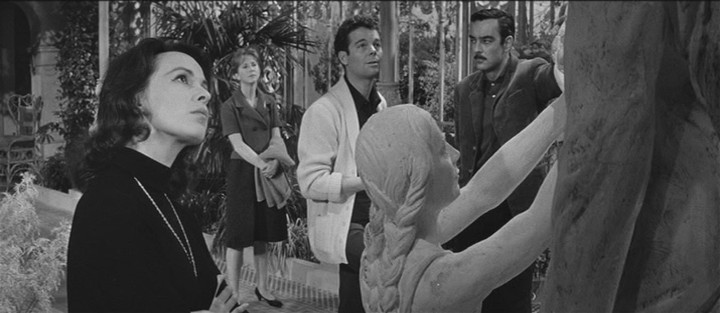Culture
The Bloody Truth: “The Haunting”

Every week in The Bloody Truth, Calhoun Kersten digs deeper into one of film’s most subtext-heavy genres: horror. Spoilers ahead.
It’s clear why The Haunting has earned its place in the annals of horror history. After all, can you think of any other movies that have so effectively elicited terror, while showing so little? The terror of the unknown is an undeniable element of, well, most horror movies, but there’s something different about The Haunting. As with any haunted house movie, the location is crucial and Hill House certainly delivers on that front. Perhaps it’s the unsettling sound design that dances between eerie/quiet and thunderous/overwhelming. While all of these elements contribute to the film’s effectiveness, The Haunting has one element that few horror films before it had and even fewer horror movies have acquired since. It has characters.
Horror has always been faulted with having cardboard cutouts of real people in lieu of actual characters. As much as I love the genre, in many instances this criticism isn’t unfounded. However, The Haunting is a rare example of the best of both worlds. The traces of the horror archetypes are all there, but The Haunting manages to transform it into something more, at least with its lead, Nell (Julie Harris). Nell has all the makings of a horror heroine. She’s lived a hard life that has transformed her into a meek and mild-mannered young woman. Horror dictates that the movie should chart her journey to rise above her checkered past and her timidity to save the day. However, things don’t exactly go as planned. Throughout the movie, she becomes increasingly unraveled and even more helpless than before she came to stay at Hill House. Honestly, her defenselessness borders on obnoxious. Furthermore, when the credits roll, she is the only casualty of the film, with all of the other characters surviving. Why is this so unusual, you may ask?
Well, for Nell’s character, it isn’t. As the movie explains, she has spent the last 11 years of her life caring for her invalid mother, who just recently died. Having spent most of her life considering the needs of others, she finally has an opportunity to get away, for something all her own. That’s what Hill House represents when she first arrives. As the secrets of the mansion unfold, she becomes more dependent on the house, but the ghosts of the place rely on her even more so. In her death, she once again fulfills the role of caretaker that, whether she knew or not, she so desperately yearned for. The most shocking element of this ending is that, well, the audience comes to feel that Nell deserves a happy ending. The Haunting gives her a bittersweet one, with her feeling needed, but only finding solace in death.
Furthermore, Nell is the type of girl who did everything right. She was attentive to her mother for 11 years, even though Nell blames herself for her mother’s death. She is soft-spoken and polite. If horror movies are Hollywood’s way of punishing audience’s for their transgressions, Nell should have been a sure shot for survival. That is part of what makes her death so… unusual, for a horror film at least. She is the redeeming human being and the only casualty. If she can’t survive a horror movie, what hope do any of the rest of us have?
That’s a distinct part of the fear of The Haunting. Even the good ones aren’t safe from the forces of evil. Most of us viewers aren’t half the humanitarian that Nell was, and even she died at Hill House. Once again, reading horror films as morality plays, the good ones are supposed to live. When they don’t, it’s admittedly kind of scary, solidifying the point that no one is safe. Especially when you consider the rest of the people in the house. The professor of the experiment is, essentially, a negligent husband who borderline flirts with one of his test subjects. Then you have a bisexual woman who defies the traditional sexual norms of the time, as well as a seemingly alcoholic, overgrown man-child. All of these people survive, yet Nell is struck down in her youth.
In the end, The Haunting delivers a convoluted message. On the one hand, it seems to be saying that even the righteous members of a horror film can be killed off. On the other hand, you could read it as being good is punished, as opposed to the others who are allowed to live out their hedonistic lives. No matter what the interpretation, it is clear that the battle between good and evil is alive and well in Hill House.